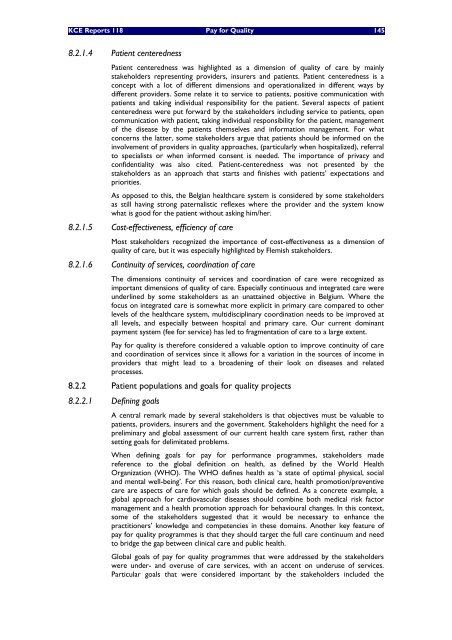Pay for Quality
Pay for Quality
Pay for Quality
You also want an ePaper? Increase the reach of your titles
YUMPU automatically turns print PDFs into web optimized ePapers that Google loves.
KCE Reports 118 <strong>Pay</strong> <strong>for</strong> <strong>Quality</strong> 145<br />
8.2.1.4 Patient centeredness<br />
Patient centeredness was highlighted as a dimension of quality of care by mainly<br />
stakeholders representing providers, insurers and patients. Patient centeredness is a<br />
concept with a lot of different dimensions and operationalized in different ways by<br />
different providers. Some relate it to service to patients, positive communication with<br />
patients and taking individual responsibility <strong>for</strong> the patient. Several aspects of patient<br />
centeredness were put <strong>for</strong>ward by the stakeholders including service to patients, open<br />
communication with patient, taking individual responsibility <strong>for</strong> the patient, management<br />
of the disease by the patients themselves and in<strong>for</strong>mation management. For what<br />
concerns the latter, some stakeholders argue that patients should be in<strong>for</strong>med on the<br />
involvement of providers in quality approaches, (particularly when hospitalized), referral<br />
to specialists or when in<strong>for</strong>med consent is needed. The importance of privacy and<br />
confidentiality was also cited. Patient-centeredness was not presented by the<br />
stakeholders as an approach that starts and finishes with patients’ expectations and<br />
priorities.<br />
As opposed to this, the Belgian healthcare system is considered by some stakeholders<br />
as still having strong paternalistic reflexes where the provider and the system know<br />
what is good <strong>for</strong> the patient without asking him/her.<br />
8.2.1.5 Cost-effectiveness, efficiency of care<br />
Most stakeholders recognized the importance of cost-effectiveness as a dimension of<br />
quality of care, but it was especially highlighted by Flemish stakeholders.<br />
8.2.1.6 Continuity of services, coordination of care<br />
The dimensions continuity of services and coordination of care were recognized as<br />
important dimensions of quality of care. Especially continuous and integrated care were<br />
underlined by some stakeholders as an unattained objective in Belgium. Where the<br />
focus on integrated care is somewhat more explicit in primary care compared to other<br />
levels of the healthcare system, multidisciplinary coordination needs to be improved at<br />
all levels, and especially between hospital and primary care. Our current dominant<br />
payment system (fee <strong>for</strong> service) has led to fragmentation of care to a large extent.<br />
<strong>Pay</strong> <strong>for</strong> quality is there<strong>for</strong>e considered a valuable option to improve continuity of care<br />
and coordination of services since it allows <strong>for</strong> a variation in the sources of income in<br />
providers that might lead to a broadening of their look on diseases and related<br />
processes.<br />
8.2.2 Patient populations and goals <strong>for</strong> quality projects<br />
8.2.2.1 Defining goals<br />
A central remark made by several stakeholders is that objectives must be valuable to<br />
patients, providers, insurers and the government. Stakeholders highlight the need <strong>for</strong> a<br />
preliminary and global assessment of our current health care system first, rather than<br />
setting goals <strong>for</strong> delimitated problems.<br />
When defining goals <strong>for</strong> pay <strong>for</strong> per<strong>for</strong>mance programmes, stakeholders made<br />
reference to the global definition on health, as defined by the World Health<br />
Organization (WHO). The WHO defines health as ‘a state of optimal physical, social<br />
and mental well-being’. For this reason, both clinical care, health promotion/preventive<br />
care are aspects of care <strong>for</strong> which goals should be defined. As a concrete example, a<br />
global approach <strong>for</strong> cardiovascular diseases should combine both medical risk factor<br />
management and a health promotion approach <strong>for</strong> behavioural changes. In this context,<br />
some of the stakeholders suggested that it would be necessary to enhance the<br />
practitioners’ knowledge and competencies in these domains. Another key feature of<br />
pay <strong>for</strong> quality programmes is that they should target the full care continuum and need<br />
to bridge the gap between clinical care and public health.<br />
Global goals of pay <strong>for</strong> quality programmes that were addressed by the stakeholders<br />
were under- and overuse of care services, with an accent on underuse of services.<br />
Particular goals that were considered important by the stakeholders included the
















